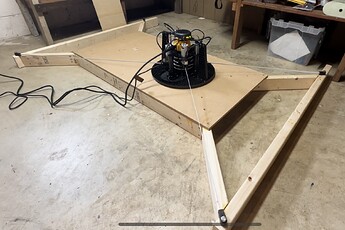I built a ~quarter-size sled for my new M4 (1740mm x 1170mm anchors with a 1200mm x 600mm target work area). I attempted to run calibration prior to setting the workspace size - my oversight. As could be expected, belts run out too far and once calibration starts, sled will run itself off the edge of the work area. I was there to catch it and STOP the machine, no problem.
I configured and saved the sizes and began calibration again. This time, it was successful, though I made the work area still too big, so M4 tilts some at the edges.
Even for a full-size setup, there seems to be a lot more belt than necessary - mine matches the pictures, but why is there more belt than fits on the spools?
I think I’m noticing that when the sled is pulling using only some of the motors, the other motors are completely idle and are rotating from friction along with the powered neighbor. This is leading to bunching on the spool. Also, because of the spool is small, the slack can lead to a bit of tangling with the other spools. Perhaps this isn’t possible, but I naively recommend giving even “idle” motors enough power to resist the friction from its neighbors.
After calibration, “Home” doesn’t do what I expected it to do, which is return to center (after some arbitrary jogs). It just jogged in a direction a few times and then M4 seemed to become unresponsive to any of the jog commands.
When I power-cycle the machine, it says I can’t do anything until I retract all again because it doesn’t know the belt lengths. When I Retract All, one anchor gets stuck on an edge and M4 thinks it’s all the way retracted. I free it, but Retract All still thinks it’s fully retracted. I Release Tension and now Retract All does pull in some each time I press it, but it is not fully retracting the belt. I had to Extend All, Stop before Retract All worked correctly.
Now, I’m trying to recalibrate with a 1160mm x 560mm to avoid sled tilt (I could add material around the border, but I don’t have any yet). When I Retract All, Extend All, Calibrate it seems to ignore the confirmed Configured/Saved size, and runs the sled right off the edge again.
Mini Frame:
Overwrapped, slacked spools:








